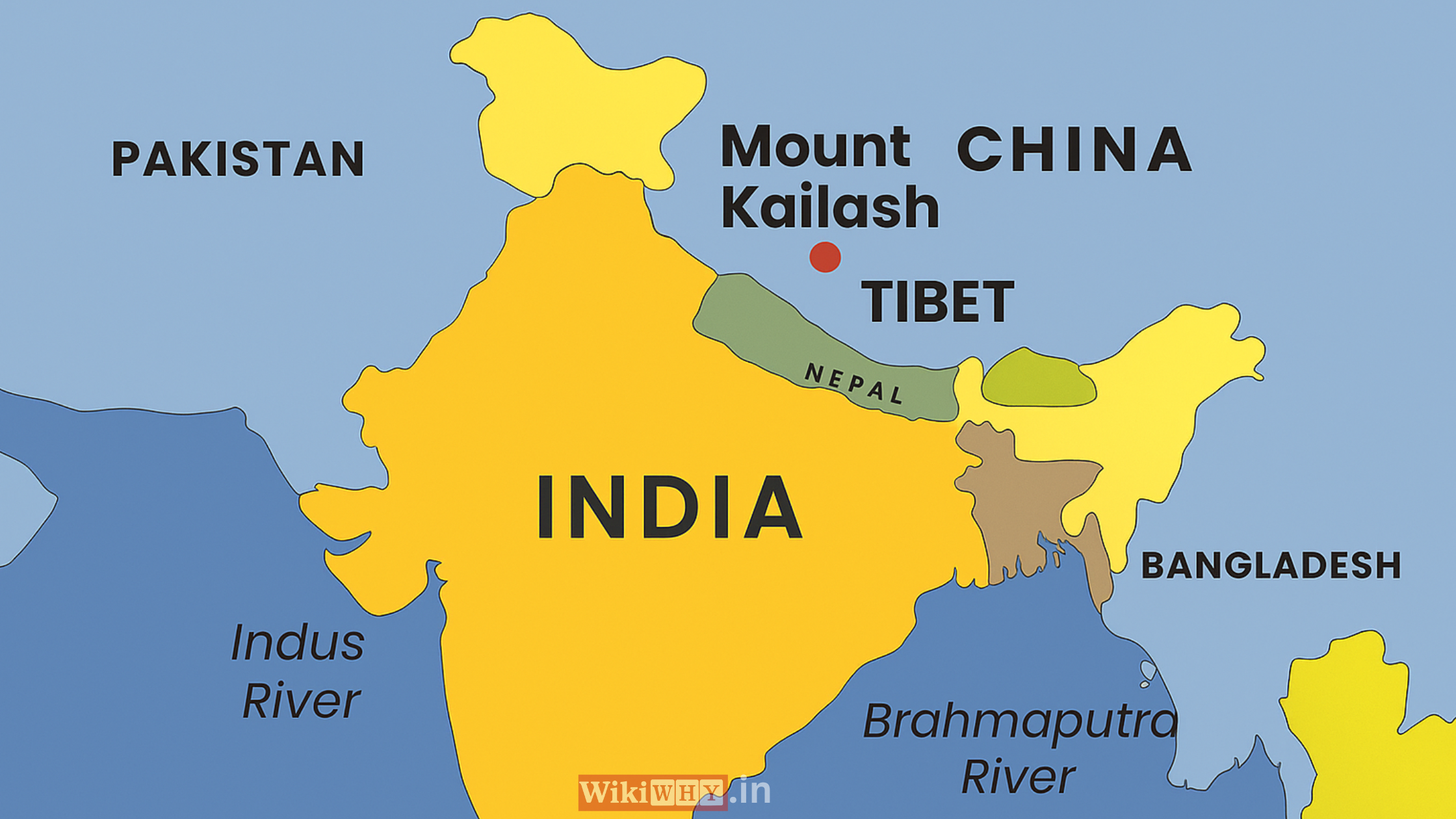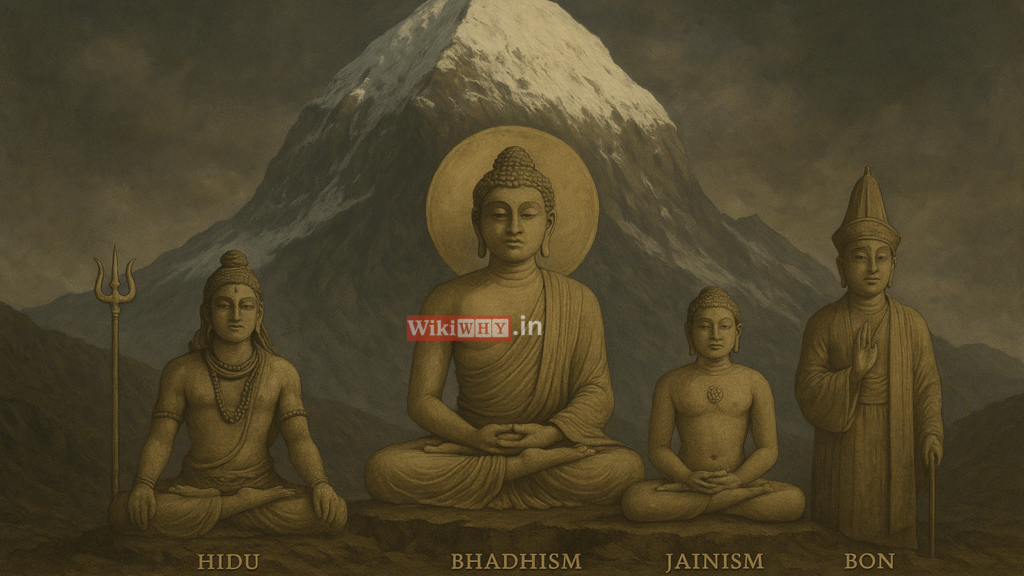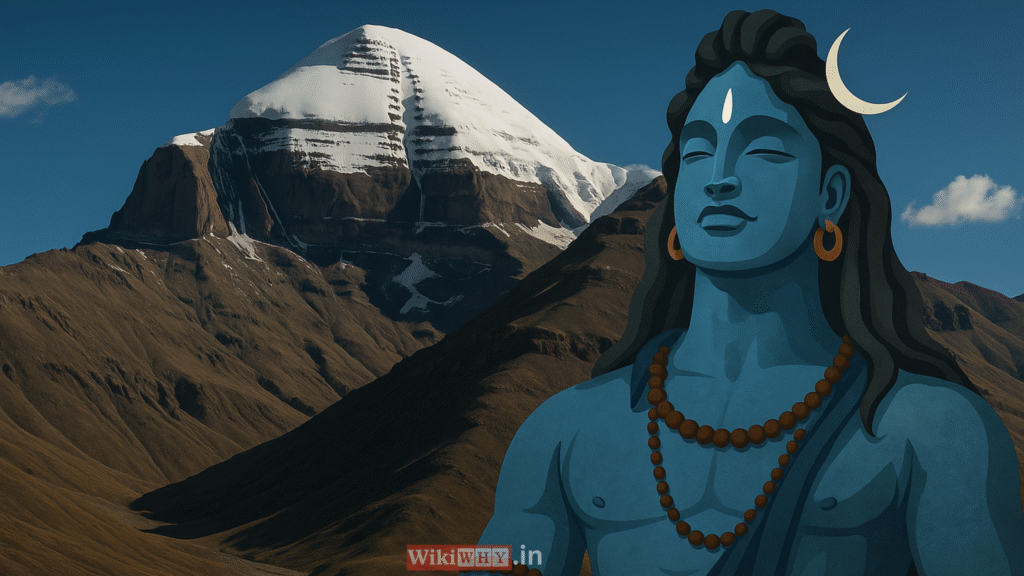A Puzzling Mountain Unique Among Others, somewhere deep in the Himalayas sits a mountain that nobody’s ever managed to climb—Mount Kailash.
Unlike Everest, where people line up to take summit selfies, this one’s never been touched. Even with all the high-tech gear we’ve got today, not a single soul has made it to the top.
Why? Is it simply an issue of challenging terrain, or is something more at work—something religious or perhaps supernatural?
In this post, we will explore the reasons why nobody has ever tried to climb Mount Kailash. We will also explore its religious significance, limited historical account, natural barriers, and the fascinating myths that are keeping it unclimbed.
We’ll also of course discuss topics such as where is Mount Kailash, why Mount Kailash is not in India, and how to visit Mount Kailash, all in an effortless and engaging tone.
So, Where Is Mount Kailash Located Exactly?

Mount Kailash is located in Tibet, not in India. Yes, it shocks many individuals, particularly given its spiritual significance in Indian culture.
But if you roll out a map, you will discover it hidden away in the back-western corner of the Tibet Autonomous Region, under Chinese rule.
The mountain is close to holy Lake Manasarovar, remote from tourist areas and even more so from normal city existence.
It is about 1,200 kilometers north of Delhi, and perhaps that explains why there are still some who ask themselves, “Is Mount Kailash in China or India?”
In all seriousness, it is not surprising that there has been confusion. For centuries, Indian pilgrims have worshipped Kailash as the spiritual home of Lord Shiva.
Therefore, many thinks it has to be within the borders of India. But actually, owing to historical changes—particularly after Tibet fell under Chinese occupation in the 1950s—the mountain presently lies firmly within China.
That’s also why individuals commonly search “Why Mount Kailash is not in India?” It’s a legitimate question, considering its spiritual connections.
But geopolitically, it’s obvious: Mount Kailash is within China, albeit millions of people feel spiritually attached to it from a distance.
It’s not easy to get there, either. With limited permits, altitude travel, and political bureaucracy in the mix, just approaching the foot of Mount Kailash is adventure enough.
This leads to some confusion understandably. One tends to seek “Mount Kailash is in India or China?”
The spiritual connection to Indian tradition exists despite its physical presence within Chinese borders.
The location stands near 1,200 kilometers from New Delhi which exists in a most distant section of the Himalayas.
If Mount Kailash holds great importance for Indian culture why do we find this sacred mountain outside of Indian territory? The answer is history.
China occupied Tibet in 1950s. Since then Mount Kailash has been beyond India’s political & geographical limits.
However, these limits could not reduce its religious significance for India.
The Sacred Significance: More Than Just a Mountain

Mount Kailash is not only an impressive mountain but also a religious symbol. It holds a sacred position in four of the world’s major religions
- Hindus consider Mount Kailash to be the residence of Lord Shiva, the destroyer and rebirther of the cosmos.
- Buddhists consider it Mount Meru, the spiritual center of all things.
- Jains assert that it’s the place where Rishabhadeva, the first Tirthankara, achieved liberation.
- Bon, the medieval Tibetan religion, regards it as the heart of the nation.
These religions consider the act of ascending Kailash to be disrespectful rather than a bravery.
The religious practice of Kora or Parikrama requires followers to walk around the mountain through a 52-kilometer circular route.
This religious journey is regarded as extremely purgative. Most believe that completing the circuit can cleanse an individual of sin from more than one life.
It is little surprise, then, that the mountain has become seen as impassable not just in form, but in heart.
Ancient Texts and Spiritual Warnings
Scriptures of religions give not only worship, but threats as well. Scripture like the Shiva Purana and Skanda Purana identify Mount Kailash as the divine abode of Lord Shiva and Goddess Parvati. It’s not a climbing place, but a divine kingdom out of reach of human beings.
Among all myths Milarepa stands as the most recognized because he was a saintly Tibetan yogi. He supposedly reached near the peak before stopping because a religious revelation occurred to him. He proclaimed that no one should ever go up on Kailash, a refrain echoed down the centuries.
Those reports only help to cement the feeling that the mountain is spiritually protected—and attempting to climb it a direct affront to powers beyond human knowledge.
Historical Attempts: Did Anyone Make It to the Top of Mount Kailash?
The first question that arises is whether anyone ever reached the summit of Mount Kailash. Many peaks around the world have been reached, Mount Kailash remains untouched—and not for lack of desire.
Reinhold Messner: A Dignified Refusal
Throughout the 1980s Reinhold Messner accepted an invitation by Chinese authorities to make an attempt at climbing it. The famous Mount Everest summit without supplemental oxygen proved Messner unfit for the invitation since he declined out of respect for Kailash’s spiritual essence.
Other Attempts Denied
Since then, other mountaineers have been interested, but either had the permits denied or abandoned the attempt. There seems to be an implicit rule, even among experienced adventurers, that Mount Kailash is off-limits by decree.
China, strangely, has chosen to preserve this unwritten rule by not granting climbing permits to Kailash, but actively encouraging mountaineering in the rest of Tibet.
Natural Barriers: Geography That Guards Itself
The mountain’s physical characteristics along with religious restrictions create an impossible climbing situation.
Distinctive Shape: The summit features steep pyramid-like faces which provide zero accessible routes for ascent.
Unpredictable Weather: Nature Doesn’t Make It Easy
The experience of bad weather at 21,000 feet is far worse than what people face at the beach. The journey toward Mount Kailash stands as a significant obstacle because of the unpredictable weather changes.
The region receives sudden snowstorms and blizzards together with rapid temperature drops from moderate warmth to deadly freezing levels during brief periods.
Glaciers in the region cause the terrain to be unstable while visibility can suddenly vanish. Climbers who possess the highest levels of experience still struggle to create reliable plans when facing such extreme environmental conditions. It is not merely troublesome since it transforms into a life-threatening circumstance.
The climbing skills alone do not suffice for this journey because you must also possess patience and good fortune while showing profound respect towards nature’s unpredictable behavior.
No Base Camps: You’re Completely on Your Own
Another major difference between Mount Kailash and more “popular” peaks like Everest or K2 is the complete absence of climbing infrastructure. No permanent base camps exist along with Sherpa teams and rescue helicopters positioned at the location.
The entire area around Kailash receives treatment as a sacred section instead of a sports ground. It hasn’t been commercialized or developed for climbers—which is rare these days. And that’s partly intentional. Local authorities, spiritual leaders, and even international governments respect the belief that Mount Kailash is not meant to be climbed.
So, anyone who even dreams of an expedition here would be facing raw nature—no backup, no guidance, no second chances. It’s just you and the mountain… and honestly, Kailash doesn’t seem to want company at the top.
Secluded Location
Days are required to travel to the base on rugged, high-altitude landscape.
All of these natural factors explain why Mount Kailash is not just sacred—it’s also awful hard.
Theories That Deepen the Mystery
Apart from religion and geography, Kailash is draped in mystical and scientific theories that only make it more enigmatic.
A Perfect Pyramid?
There is also the fact, according to some researchers and geologists, that the four sides of the mountain are virtually perfectly orientated along the cardinal directions.
This has raised the theory that Kailash is a man-made, ancient pyramid, or at least something so symmetrical that it must be man-made.
Energy Fields and Magnetic Anomalies
Between 1990 and 1999 Russian scientists discovered unusual magnetic field patterns during their survey of Mount Kailash. Scientists proposed Mount Kailash exists as a connection point to an ancient worldwide energy system which includes Egypt’s Great Pyramids.
Whether or not these ideas have scientific merit, they’ve at least contributed to the mystique that Mount Kailash is more than simply rock and ice—it’s a power center on Earth.
Why Mount Kailash Is Center of Earth
This brings us to another common question: Why Mount Kailash is center of Earth?
Hindu and Buddhist cosmology identifies Mount Kailash as the universal axis called Mount Meru which controls the rotation of the entire universe.
The great Asian rivers Indus Sutlej Brahmaputra and Karnali begin their journeys near Kailash before flowing in four distinct directions.
Such a perfect symmetry appears to be completely intentional. The additional idea strengthens the argument that the mountain stands as a cosmic focal point which most people believe emits divine energy that connects the earthly realm with the heavenly sphere.
How to Go to Mount Kailash: The Pilgrim’s Path
The second question emerges among people because climbing the Mount remains impossible: How can Mount Kailash be reached?
The sacred Kailash Mansarovar Yatra remains accessible for pilgrims and spiritual travelers but securing access requires more than standard vacation arrangements.
All visitors must approach authorized Indian or Nepalese tour operators which manage every aspect of paperwork and logistics including Chinese authority approvals because the area exists in Tibetan territory.
Popular Routes to Kailash:
- Via Lipulekh Pass (Uttarakhand) – Trekking and acclimatization is required.
- Via Nathu La Pass (Sikkim) – Less demanding but normally limited in quantities.
- Via Nepal (Simikot-Hilsa) – Favorite of the majority of foreign trekkers.
The Chinese administration of Tibet forces travelers to obtain permits along with group travel requirements. The trekking experience offers challenging physical demands yet delivers an inspiring transformative spiritual journey.
Why Mount Kailash Is Unclimbable: Final Thoughts
Let us consider briefly the many reasons Mount Kailash has never been climbed—and likely never will be:
| Reason | Description |
| Religious Significance | Hailed by Hindus, Buddhists, Jains, and Bon practitioners. |
| Geopolitical Restrictions | The Chinese government does not grant climbing permits to any individual. |
| Geographical Challenges | The mountain presents various challenges because it has difficult rocks and no clear path along with inclement weather and extreme altitude. |
| Spiritual Warnings | The mountain remains off-limits due to warnings found in legends and scriptures which discourage |
Conclusion: The Summit That Remains Holy
It’s a world where all mountains seem to have a climbing fate bequeathed to them, yet Mount Kailash is the sole exception. The mountain stands apart because of its elevation combined with its structure and its unfathomable steepness.
The mountain generates an intense spiritual response which evokes feelings of deep respect alongside feelings of awe and spirituality.
People who approach it through spiritual perspective or scientific analysis or mystical interpretation must accept this fact: Mount Kailash exists beyond human defeat because it demands worship.
Frequently Asked Questions(FAQs) About Mount Kailash
Q1. Where is Mount Kailash?
Mount Kailash stands in the Tibet Autonomous Region near the sacred Lake Manasarovar. The mountain is revered for its untouched nature and spiritual significance, adding to its geographical and symbolic importance.
Q2. Has anyone ever climbed Mount Kailash?
Many have attempted to climb Mount Kailash, but no one has ever succeeded. It remains unconquered due to religious beliefs and natural challenges.
Q3. Why is Mount Kailash not in India?
Mount Kailash is located within the political borders of Tibet, which is currently governed by China.
Q4. Why is Mount Kailash considered the center of the Earth?
According to religious beliefs, Mount Kailash is the axis mundi—the spiritual and cosmic center of the Earth. It is also near the sources of four major rivers, reinforcing this symbolic idea.
Q5. How to reach Mount Kailash?
Travelers can reach Mount Kailash via pilgrimage routes through India or Nepal. A permit issued by China is required to enter the region.













